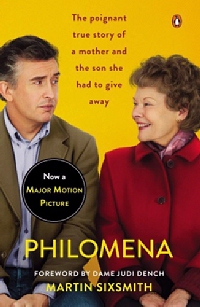
Philomena
by Martin Sixsmith
Penguin, 2013 (Reprint)
Reviewed by Barbara Free, M.A.
She had, indeed, signed away her parental rights, but under duress. She was a young and very unsophisticated girl when she became pregnant, without even the knowledge of how one became pregnant. She met the birth father at a local fair and was enraptured by him, and he by her. When her aunt, with whom she was living at the time, saw that she had really enjoyed the outing, she immediately locked her in her room and would not allow her out to meet the young man again, so there is no knowledge of how he felt at not finding her where they’d agreed to meet, or of what happened to him later. At the time the book was written, Philomena was trying to find out more about him. By the time her father and the aunt figured out Philomena was pregnant, she was several months along, and the father immediately took her to the convent and left her there.
As the movie portrays them, the nuns there were abusive and shaming, with the exception of Sister Annunciata, a young nun who helped Philomena in labor and probably saved her life. Before this young nun was sent somewhere else, she did manage to help Philomena as much as she could, including taking photos of her son with a smuggled box Brownie camera. The young women were essentially slaves, working in the laundry all day and seeing their children only an hour a day once they were weaned. Philomena obtained from one of her brothers a few Pounds and asked Sister Annunciata to go into town for her and get a few little toys for Anthony, including the tin airplane which we see in the film and which he has in the few pictures of his early childhood, both at the convent (orphanage is not a proper title for this place, because the children were not orphans) and after his adoption by the Hesses. The little airplane was the one toy he did not share with other children. Its presence in the photographs helped establish for sure that he was, in fact, Philomena’s son.
While the film depicts Philomena’s efforts to find her child, the book is more of a biography of the son, reconstructed from information provided by those who knew him, including Michael’s adopted sister, Mary, who was the daughter of a fellow “inmate” at the Abbey, and his partner at the time of his death, Pete Nilsson. One of many details that is different in the book is that the sister had also been searching, and had been to the convent with her brother.
Michael and Mary were extremely close throughout their childhood. Their physician adoptive father was tyrannical, while their mother was loving, but rather passive, having adopted the children in an attempt to please her husband because she’d had three sons and no daughters: Philomena’s son was only adopted by the Hesses because the two children were so inseparable. Afterwards, their adoptive father tried at various times to return them as “defectives,” because they weren’t speaking English or were too shy. He did not even realize they were speaking Gaelic, not “gibberish.”
There is a fair amount of detail about Michael Hess’s private life as a gay man, particularly his propensity to engage in high-risk sexual activity, which is how he became infected with HIV. These portions were hard for this writer to read, because, having seen the film, I knew the eventual outcome and yet kept hoping for something better. As a birth mother, the urge to protect kept coming through. I finally read the rest of the book and then went back to read those difficult portions. Others may not be as bothered, or may be more so. After thirty years of being a therapist, I am not easily shocked by anyone’s life, but as a mother, it was hard not to have a protective view.
After reading the book, I saw the film a second time, and found that helpful. We have heard there is a film sequel in the works, and will certainly want to see it. As for the book, it is recommended reading for anyone with an adoption connection, and Philomena Lee is to be commended for her courage, not only in searching, but in allowing her story to be made public. Martin Sixsmith was also courageous in helping her so faithfully and doing such a fine job of writing, but also in allowing his own struggles with this situation to be portrayed. He could have, after all, just written the story without disclosing his own involvement or viewpoint, or he could have dropped the whole project when it became difficult. Instead, he allowed his own life to be changed by Philomena.
This book is available through Amazon, and will no doubt see a resurgence in sales since the success of the film. This is an important book for birth parents, for adoptive parents, for adoptees, and for anyone who wants to know the truth about the history of Irish convent laundries, or the truth about many political developments in the 1970s, ’80s, and early 1990s.
Excerpted from the April 2014 edition of the Operation Identity Newsletter
© 2014 Operation Identity